Lemon cucumber seed starting can feel like a daunting task, but trust me, it’s easier than you think! Have you ever dreamed of strolling through your own backyard, plucking a perfectly ripe, sunshine-yellow lemon cucumber straight from the vine? Imagine the crisp, refreshing taste of this unique fruit, adding a delightful twist to your summer salads and snacks. Well, stop dreaming and start planting!
For centuries, home gardening has been a source of sustenance and joy. From the ancient hanging gardens of Babylon to the victory gardens of World War II, growing your own food connects us to a rich history of self-sufficiency and a deeper understanding of nature. And while lemon cucumbers might not have the same historical weight as, say, tomatoes, their quirky appearance and delicious flavor make them a modern-day garden favorite.
But why bother with lemon cucumber seed starting at all? Because store-bought produce often lacks the freshness and flavor of homegrown varieties. Plus, you have complete control over what goes into your garden, ensuring that your lemon cucumbers are free from harmful chemicals and pesticides. In this article, I’m going to share my tried-and-true DIY tricks and hacks for successfully starting lemon cucumber seeds, so you can enjoy a bountiful harvest of these delightful fruits. Let’s get our hands dirty and transform your garden into a lemon cucumber paradise!

Starting Lemon Cucumber Seeds: A Gardener’s Guide
Hey there, fellow gardening enthusiasts! I’m so excited to share my tried-and-true method for starting lemon cucumber seeds. These quirky, adorable cucumbers are a delightful addition to any garden, and starting them from seed gives you a head start on the growing season. Trust me, the satisfaction of harvesting your own homegrown lemon cucumbers is unmatched!
Why Start Lemon Cucumber Seeds Indoors?
While you *can* direct sow lemon cucumber seeds, starting them indoors offers several advantages:
* Extended Growing Season: You can get a jump start on the season, especially if you live in a cooler climate with a shorter growing period.
* Protection from Pests and Diseases: Seedlings are vulnerable, and starting them indoors shields them from common garden pests and diseases.
* Control Over Environment: You can provide the ideal temperature, light, and moisture levels for optimal germination and early growth.
* Stronger Plants: Indoor-started seedlings tend to be stronger and more resilient when transplanted outdoors.
Materials You’ll Need
Before we dive in, let’s gather all the necessary supplies. Having everything on hand will make the process smooth and enjoyable.
* Lemon Cucumber Seeds: Obviously! Make sure you’re using fresh seeds from a reputable source.
* Seed Starting Trays or Pots: I prefer using seed starting trays with individual cells, but small pots (2-3 inches in diameter) work just as well.
* Seed Starting Mix: This is crucial! Don’t use regular potting soil, as it’s too heavy for delicate seedlings. Seed starting mix is light, airy, and well-draining.
* Watering Can or Spray Bottle: For gentle watering.
* Heat Mat (Optional): Lemon cucumbers prefer warm soil for germination. A heat mat can significantly improve your success rate.
* Grow Lights (Optional): If you don’t have a sunny windowsill, grow lights will provide the necessary light for healthy seedling growth.
* Clear Plastic Dome or Plastic Wrap: To create a humid environment for germination.
* Plant Labels: To keep track of what you’ve planted. Trust me, you’ll thank yourself later!
* Small Trowel or Spoon: For handling the seed starting mix.
Step-by-Step Instructions: Sowing the Seeds
Now for the fun part! Let’s get those lemon cucumber seeds planted.
1. Prepare the Seed Starting Trays/Pots: Fill your seed starting trays or pots with seed starting mix. Gently tap the trays to settle the mix, but don’t pack it down too tightly. You want it to be light and airy.
2. Moisten the Seed Starting Mix: Water the mix thoroughly until it’s evenly moist, but not soggy. You can use a watering can or spray bottle. I like to use a spray bottle to avoid disturbing the soil.
3. Sow the Seeds: Make a small indentation (about 1/2 inch deep) in the center of each cell or pot. Place one or two lemon cucumber seeds in each indentation. I usually plant two seeds per cell just in case one doesn’t germinate.
4. Cover the Seeds: Gently cover the seeds with seed starting mix. Lightly tap the surface to ensure good contact between the seeds and the mix.
5. Water Again: Lightly water the surface of the mix to settle everything in place. Again, be gentle!
6. Create a Humid Environment: Cover the seed starting trays with a clear plastic dome or plastic wrap. This will help retain moisture and create a humid environment, which is essential for germination.
7. Provide Warmth: Place the seed starting trays on a heat mat, if you’re using one. Lemon cucumber seeds germinate best at temperatures between 70-80°F (21-27°C).
8. Label Everything: Don’t forget to label your trays or pots with the date and the type of seed you planted.
Germination and Early Growth
This is where patience comes in! It usually takes about 5-10 days for lemon cucumber seeds to germinate.
1. Monitor Moisture Levels: Check the seed starting mix daily to ensure it remains moist. If the surface feels dry, lightly mist it with water. Avoid overwatering, as this can lead to fungal diseases.
2. Maintain Warmth: Keep the heat mat on until the seeds germinate.
3. Ventilation: Once the seeds start to germinate, remove the plastic dome or plastic wrap for a few hours each day to allow for ventilation. This will help prevent fungal diseases.
4. Provide Light: Once the seedlings emerge, they need plenty of light. If you’re using a sunny windowsill, rotate the trays regularly to ensure even growth. If you’re using grow lights, position them a few inches above the seedlings.
5. Thinning (If Necessary): If you planted two seeds per cell and both germinate, you’ll need to thin them out. Choose the strongest seedling and gently snip off the weaker one at the soil line. Don’t pull it out, as this can disturb the roots of the remaining seedling.
Hardening Off the Seedlings
Before transplanting your lemon cucumber seedlings outdoors, you need to “harden them off.” This process gradually acclimates them to the outdoor environment, making them less susceptible to shock.
1. Start Slowly: Begin by placing the seedlings outdoors in a sheltered location (e.g., a porch or patio) for just a few hours each day.
2. Gradually Increase Exposure: Over the course of a week or two, gradually increase the amount of time the seedlings spend outdoors each day.
3. Protect from Harsh Conditions: Protect the seedlings from direct sunlight, strong winds, and frost.
4. Monitor for Stress: Watch for signs of stress, such as wilting or leaf burn. If you notice any of these signs, bring the seedlings back indoors and reduce their outdoor exposure.
Transplanting Outdoors
Once your lemon cucumber seedlings are hardened off and the danger of frost has passed, it’s time to transplant them into your garden!
1. Choose a Sunny Location: Lemon cucumbers need at least 6-8 hours of sunlight per day.
2. Prepare the Soil: Amend the soil with compost or other organic matter to improve drainage and fertility.
3. Dig Holes: Dig holes that are slightly larger than the root balls of the seedlings. Space the holes about 18-24 inches apart.
4. Gently Remove Seedlings: Carefully remove the seedlings from their trays or pots. Be gentle to avoid damaging the roots.
5. Plant the Seedlings: Place the seedlings in the holes and gently backfill with soil.
6. Water Thoroughly: Water the seedlings thoroughly after planting.
7. Mulch: Apply a layer of mulch around the plants to help retain moisture and suppress weeds.
8. Provide Support: Lemon cucumbers are vining plants, so they’ll need some kind of support, such as a trellis or fence.
Caring for Your Lemon Cucumber Plants
Once your lemon cucumber plants are established, they’re relatively easy to care for.
1. Water Regularly: Water deeply and regularly, especially during hot, dry weather.
2. Fertilize: Fertilize every few weeks with a balanced fertilizer.
3. Pest and Disease Control: Monitor your plants regularly for pests and diseases. Take action promptly if you notice any problems.
4. Harvest: Harvest the lemon cucumbers when they are about the size of a golf ball and have a pale yellow color. The more you harvest, the more the plant will produce!
Troubleshooting
Even with the best planning, things can sometimes go wrong. Here are a few common problems you might encounter and how to address them:
* Poor Germination: If your seeds aren’t germinating, make sure the soil is warm enough and that you’re not overwatering. Also, check the expiration date on your seeds.
* Leggy Seedlings: Leggy seedlings are tall and spindly, usually due to insufficient light. Provide more light by moving them to a sunnier location or using grow lights.
* Damping Off: Damping off is a fungal disease that can kill seedlings. To prevent it, use a sterile seed starting mix, avoid overwatering, and provide good ventilation.
* Pests: Common cucumber pests include aphids, cucumber beetles, and squash bugs. Use insecticidal soap or other appropriate treatments to control them.
* Diseases: Common cucumber diseases include powdery mildew and downy mildew. Use fungicides or other appropriate treatments to control them.
Enjoy Your Harvest!
Growing lemon cucumbers from seed is a rewarding experience. With a little patience and care, you’ll be enjoying a bountiful harvest of these unique and delicious cucumbers in no time. I

Conclusion
So, there you have it! Starting your own lemon cucumber seeds is not only surprisingly simple, but it’s also incredibly rewarding. Imagine biting into a crisp, refreshing lemon cucumber grown with your own two hands. The taste is far superior to anything you’ll find in a grocery store, and the satisfaction of nurturing a plant from seed to harvest is unmatched.
This DIY trick is a must-try for several reasons. First, it gives you complete control over the growing process. You can choose organic seeds, use your preferred soil, and avoid any harmful pesticides or herbicides. Second, it’s significantly more cost-effective than buying lemon cucumber seedlings from a nursery. A packet of seeds costs just a few dollars, and you can grow dozens of plants from it. Third, it allows you to start your plants indoors, giving them a head start on the growing season, especially crucial in regions with shorter summers.
But the best reason to try starting your own lemon cucumber seeds is the sheer joy of gardening. It’s a therapeutic activity that connects you with nature and provides a sense of accomplishment. Watching those tiny seeds sprout and grow into vibrant plants is truly magical.
Don’t be afraid to experiment with variations! Try different soil mixes to see what works best for your climate and growing conditions. Consider using different types of containers, from traditional pots to repurposed yogurt containers. You can even try succession planting, starting new seeds every few weeks to ensure a continuous harvest throughout the summer. Another fun variation is to try growing your lemon cucumbers vertically on a trellis or fence. This saves space and keeps the fruits clean and off the ground.
Remember to provide your lemon cucumber seedlings with plenty of sunlight, water, and nutrients. Once they’re big enough, transplant them into your garden or larger containers. With a little care and attention, you’ll be enjoying delicious, homegrown lemon cucumbers in no time.
We wholeheartedly encourage you to give this DIY trick a try. It’s a fun, easy, and rewarding way to grow your own food. And most importantly, it allows you to enjoy the unique flavor and texture of lemon cucumbers at their absolute freshest.
So, grab a packet of seeds, get your hands dirty, and experience the joy of growing your own lemon cucumbers. We’re confident that you’ll be hooked!
Once you’ve tried this method, we’d love to hear about your experience. Share your tips, tricks, and photos in the comments below. Let’s build a community of lemon cucumber enthusiasts and help each other grow the best possible crop! Your insights could be invaluable to other gardeners just starting out. Happy gardening!
Frequently Asked Questions (FAQ)
What is the best time to start lemon cucumber seeds indoors?
The ideal time to start your lemon cucumber seeds indoors is about 3-4 weeks before the last expected frost in your area. This gives the seedlings enough time to develop a strong root system before being transplanted outdoors. Check your local weather forecasts and planting guides to determine the average last frost date for your region. Starting too early can result in leggy, weak seedlings that struggle to adapt to outdoor conditions. Starting too late may shorten your growing season and reduce your overall harvest.
What type of soil is best for starting lemon cucumber seeds?
A well-draining seed starting mix is crucial for successful germination. Avoid using garden soil, as it can be too heavy and may contain pathogens that can harm young seedlings. Look for a seed starting mix that contains ingredients like peat moss, vermiculite, and perlite. These ingredients provide good drainage, aeration, and moisture retention. You can also make your own seed starting mix by combining equal parts peat moss, vermiculite, and perlite. Ensure the mix is slightly moist before sowing the seeds.
How deep should I plant lemon cucumber seeds?
Plant lemon cucumber seeds about ½ inch deep in the soil. Make a small indentation in the soil, drop in the seed, and gently cover it with soil. Lightly pat down the soil to ensure good contact between the seed and the soil. Avoid planting the seeds too deep, as they may not be able to emerge from the soil. Also, avoid planting them too shallow, as they may dry out quickly.
How often should I water lemon cucumber seedlings?
Keep the soil consistently moist but not waterlogged. Water the seedlings gently whenever the top inch of soil feels dry to the touch. Avoid overwatering, as this can lead to root rot. Use a spray bottle or watering can with a gentle nozzle to avoid disturbing the delicate seedlings. Bottom watering is also a good option. Place the container in a tray of water and allow the soil to absorb the water from the bottom.
How much light do lemon cucumber seedlings need?
Lemon cucumber seedlings need plenty of light to grow strong and healthy. Place them in a sunny windowsill that receives at least 6-8 hours of direct sunlight per day. If you don’t have a sunny windowsill, you can use grow lights. Position the grow lights a few inches above the seedlings and keep them on for 14-16 hours per day. Rotate the seedlings regularly to ensure even growth.
When can I transplant lemon cucumber seedlings outdoors?
Transplant lemon cucumber seedlings outdoors when the danger of frost has passed and the soil has warmed up to at least 60°F (15°C). Harden off the seedlings for a week before transplanting them. This involves gradually exposing them to outdoor conditions for increasing periods of time each day. Start by placing them in a sheltered location for an hour or two, and gradually increase the time they spend outdoors each day. This will help them acclimate to the sun, wind, and temperature changes.
What are some common problems when starting lemon cucumber seeds?
Some common problems include poor germination, damping off, and leggy seedlings. Poor germination can be caused by using old seeds, planting the seeds too deep, or keeping the soil too dry or too wet. Damping off is a fungal disease that can kill young seedlings. To prevent damping off, use a sterile seed starting mix, avoid overwatering, and provide good ventilation. Leggy seedlings are caused by insufficient light. Provide your seedlings with plenty of light to prevent them from becoming leggy.
Can I grow lemon cucumbers in containers?
Yes, lemon cucumbers can be successfully grown in containers. Choose a container that is at least 12 inches in diameter and 12 inches deep. Make sure the container has drainage holes to prevent waterlogging. Use a well-draining potting mix and provide the plants with plenty of sunlight, water, and nutrients. Consider using a trellis or stake to support the vines.
How long does it take for lemon cucumbers to mature?
Lemon cucumbers typically mature in about 60-70 days from planting. You can harvest them when they are about the size of a lemon and have a pale yellow color. The skin should be smooth and firm. Overripe lemon cucumbers will turn orange and become bitter.
What are some companion plants for lemon cucumbers?
Good companion plants for lemon cucumbers include beans, corn, dill, marigolds, nasturtiums, and radishes. These plants can help to deter pests, attract pollinators, and improve the overall health of the lemon cucumber plants. Avoid planting lemon cucumbers near potatoes or sage, as these plants can inhibit their growth.




Leave a Comment